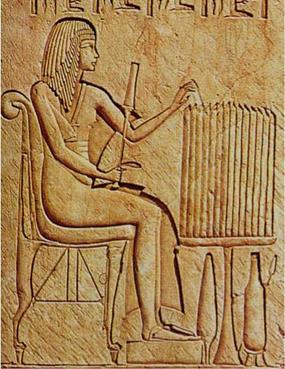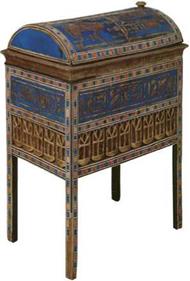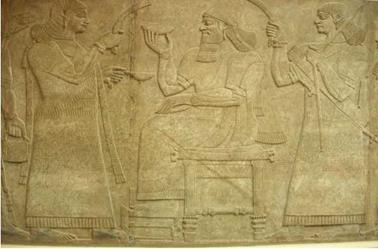We learn about the material culture of the Assyrians mainly from archaeological excavations. Assyrian furniture was usually cast from bronze and shelving, much like in Egypt, placed on supports in the form of lion paws. Also, many carvings and sculptures take the form of animal heads, their full figures, as well as numerous
|

 Fig. 1.11 Jewellery box. Valley of Kings, Tjuyu’s tomb, 18th dynasty, Amenhotep III’s rule, the years 1387-1350 B. C. (Cairo Museum in Egypt)
Fig. 1.11 Jewellery box. Valley of Kings, Tjuyu’s tomb, 18th dynasty, Amenhotep III’s rule, the years 1387-1350 B. C. (Cairo Museum in Egypt)
|
Fig. 1.12 Palace in Nimrud, relief presenting king Ashurnasirpal II on the throne, next to which a footrest is standing, around 865-860 B. C. (British Museum) |
human figures. Characteristics of the Assyrian culture were also platforms that constituted small construction forms resembling skeletal structures, upon which the actual piece of furniture was set. Thanks to such a solution, the Persians obtained the impression that a seated person has an advantage over a standing one, which was to arouse due respect to the ruler. Structurally, this effect was achieved by applying numerous turned spheres and spirals on which the legs of chairs, armchairs and platforms were set (Fig. 1.12).
Chairs and armchairs were richly lined with colourful textile materials. This particular feature distinguished Assyrian furniture from many others, but these achievements were commonly used by both Greeks and Romans.
Assyrian beds were much higher than Egyptian ones, as the Persians received guests and celebrated at lavishly set tables in reclining positions. Assyrian furniture was extremely massive, heavy, oversized and impractical. Their main task was to emphasise social position of the user, rather than to provide him with maximum comfort of use.



